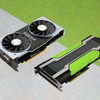AMD or Intel Inside?

Dell PowerEdge servers come in models optimized for Intel or AMD processors. But how do you know if the PowerEdge model you’re looking at is an Intel or an AMD server? Turns out, it’s all in the title. Dell PowerEdge model names typically consist of a letter followed by either 3 or 4 digits. Here’s how to tell what’s what.
Dell PowerEdge Naming Conventions
Three digit naming convention
If you’re working with a server model with three digits in the name, the digits translate to the following:
The first digit after the letter indicates the class of the system.
(First digit = how many CPUs the system is intended to support.)
- 1-3 = a 1x CPU system.
- 4-7 = a 2x CPU system.
- 8 = 2 or 4 CPU's
- 9 = 4 CPU's.
The second digit indicates the generation, with "0" for 10th generation, "1" for 11th generation, and so on.
And in this case, the third digit is what indicates the make of the CPU, with "0" for Intel and "5" for AMD.
For example, the R740 model…
(7) Is a Rack 2 CPU system
(4) Is a 14th generation server
(0) With Intel processors
And the R815 model (throwback)…
(8) Is a Rack 2 CPU system
(1) Is an 11th generation server
(5) With AMD processors
Four digit naming convention
On the other hand, if you’re working with a 4-digit title, a few things get reshuffled. The first digit after the letter indicates the default iDRAC license, aka the class of the system. If the first digit in the name is 1-5, the system’s default is iDRAC Basic. If the first digit is 6 - 9, the system’s default is iDRAC Express.
Just like the 3-number naming convention, the second digit in the 4-digit names indicates the generation, with 0 for 10th generation, 1 for 11th generation and so on.
According to Dell, the third digit “often” indicates the number of CPU sockets, 1 for 1 CPU and 2 for 2 CPUs. (We’ve yet to find an exception, but if you know of any, feel free to comment and let us know.)
In the case of 4-digit names, it’s that fourth digit that indicates the make of the CPU, with “0” for Intel and “5” for AMD.
For example, the R6515 model…
(6) Defaults to iDRAC Express
(5) Is a 15th generation server
(1) Is a Rack 1 CPU system
(5) With AMD processors
And the C6420* model…
(6) Defaults to iDRAC Express
(4) Is a 14th generation server
(2) Is a Rack 2 CPU system
(5) With Intel processors
*Note: Where the “R” in the title stands for Rack-mountable, “C” stands for Compute.
Dell stopped releasing AMD servers with 3-digit titles after their 11th generation of servers (with the last ones being the R415, R515, and R815). However, a server model having 4 digits in the name doesn’t mean you’re automatically looking at an AMD server; for example, take the C4130, C6220, and the C6420.
The immediate way to tell if a 3-digit or 4-digit Dell PowerEdge is an Intel or an AMD server is by looking at the final digit of the server model’s name, with “0” for Intel and “5” for AMD.
Equivalent AMD and Intel Dell PowerEdge Servers
Some of these Intel- and AMD-optimized PowerEdge variants share very similar hardware and features (aside from the CPU optimization).
Here’s the list of comparable 14th and 15th Gen PowerEdges:
|
Intel PowerEdge Server |
AMD PowerEdge Server |
|
|
15th Gen PowerEdge Servers |
Dell PowerEdge R750 / R750xd |
Dell PowerEdge R7525 |
|
Dell PowerEdge R550 |
Dell PowerEdge R7515 |
|
|
Dell PowerEdge R650 |
Dell PowerEdge R6525 |
|
|
Dell PowerEdge R450 |
Dell PowerEdge R6515 |
|
|
14th Gen PowerEdge Servers |
Dell PowerEdge R7425 |
|
|
Dell PowerEdge R540 |
Dell PowerEdge R7415 |
|
|
Dell PowerEdge R6425 |
||
|
Dell PowerEdge R440 |
Dell PowerEdge R6415 |
So which one’s right for me? (The Great Debate)
Which is better, AMD or Intel?

Well, that depends on who you ask. (And what you want to do with your server.)
Generally speaking, servers with AMD’s EPYC and Ryzen-powered processors tend to win on speed. And they’re pretty energy efficient, too; EPYC systems have been tested to draw less power for the compute capabilities they provide, potentially allowing you to save on long-term energy costs. (More on AMD energy efficiency here.)
As for the Intel side... well, they've been making Xeons since '98, vs. Ryzens' start in 2017. Many IT teams have a lot more experience with Xeon-based management, which will be especially helpful if you’re just starting out. It’s proven architecture with a good deal of documentation. And if your immediate budget doesn’t have much wiggle room, an Intel-equipped server is still absolutely a competitive pick, with Intel’s Raptor Lake chips still “offer[ing] a superior price-to-performance ratio in a broad swath of workloads”*.
*(Keep in mind that the tests that were run here are most relevant for gaming and workstation CPUs.)
When choosing between Intel and AMD CPUs, the most important thing to keep in mind will be… drum roll please…. the applications you plan on using! (Big surprise there.) No, but seriously. If your apps tend to leverage more cores or memory channels, AMD may have an advantage. But if you prioritize mature software support, Intel tends to edge out.
If you’re looking to go deeper into CPU benchmarking, know that there are different relevant benchmarks for different types of enterprise workloads. For example, if you’re processing large datasets, you’ll want to get an idea of the transactions per minute or queries per second, as well as high FLOPS. On the other hand, if you’re running backend application logic and middleware for said enterprise apps (too meta?), you’ll want to get an idea of the IOPS, request throughput, and response latency.
For more direct AMD and Intel comparisons and benchmarking guides, check out the following articles:
- Best Performance AMD and Intel CPUs (by Tom's Hardware)
- How to Benchmark Your CPU (from Tom’s Hardware’s official CPU Benchmarks and Hierarchy 2024: CPU Rankings.)
When you peel back the Intel vs AMD debate, Dell PowerEdge servers powered by either vendor can deliver the performance you need - you just have to match your apps and benchmarks to the right model. And now that you know how to ID AMD vs Intel models and evaluate the key metrics, you can find your perfect PowerEdge server fit!
Still need help deciding? Don't be a stranger - drop a comment or shoot one of our techs a message at info@techmikeny.com!
















